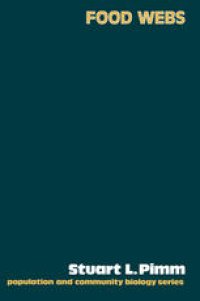
Ebook: Food Webs
Author: Stuart L. Pimm (auth.)
- Tags: Science general
- Series: Population and Community Biology
- Year: 1982
- Publisher: Springer Netherlands
- Edition: 1
- Language: English
- pdf
Often the meanings of words are changed subtly for interesting reasons. The implication of the word 'community' has changed from including all the organisms in an area to only those species at a particular trophic level (and often a taxonomically restricted group), for example, 'bird-community'. If this observation is correct, its probable cause is the dramatic growth in our knowledge of the ecological patterns along trophic levels (I call these horizontal patterns) and the processes that generate them. This book deals with vertical patterns - those across trophic levels -and tries to compensate for their relative neglect. In cataloging a dozen vertical patterns I hope to convince the reader that species interactions across trophic levels are as patterned as those along trophic levels and demand explanations equally forcefully. But this is not the only objective. A limited number of processes shape the patterns of species interaction; to demonstrate their existence is an essential step in understanding why ecosystems are the way they are. To achieve these aims I must resort to both mathematical techniques to develop theories and statistical techniques to decide between rival hypotheses. The level of mathematics is likely to offend nearly everyone. Some will find any mathematics too much, while others will consider the material to be old, familiar ground and probably explained with a poor regard for rigour and generality.
1 Food webs.- 1.1 What and why?.- 1.2 Where?.- 1.3 How?.- 2 Models and their local stability.- 2.1 Introduction.- 2.2 Models.- 2.3 Stability.- 2.4 Summary.- Appendix 2A: Taylor’s expansion.- Appendix 2B: An example of calculating eigenvalues.- Appendix 2C: Jacobian matrices.- 3 Stability: other definitions.- 3.1 Introduction.- 3.2 Global stability.- 3.3 Species deletion stability.- 3.4 Stability in stochastic environments.- 3.5 Other stability criteria.- 3.6 Summary: models and their stabilities — Is there a best buy?.- 4 Food web complexity I: theoretical results.- 4.1 Introduction.- 4.2 Bounds on food web complexity: local stability.- 4.3 Complexity and stability under large perturbations.- 4.4 Summary of theoretical results.- 5 Food web complexity II: empirical results.- 5.1 Direct tests.- 5.2 Indirect tests.- 5.3 Summary.- 6 The length of food chains.- 6.1 Introduction.- 6.2 Hypothesis A: Energy flow.- 6.3 Hypothesis B: Size and other design constraints.- 6.4 Hypothesis C: Optimal foraging; why are food chains so long?.- 6.5 Hypothesis D: Dynamical constraints.- 6.6 Summary.- Appendix 6A: Drawing inferences about food web attributes.- 7 The patterns of omnivory.- 7.1 Models of omnivory.- 7.2 Testing the hypotheses.- 7.3 Summary.- 8 Compartments.- 8.1 Reasons for a compartmented design.- 8.2 Testing the hypotheses: habitats as compartments.- 8.3 Testing the hypotheses: compartments within habitats.- 8.4 Four comments.- 8.5 Summary.- 9 Descriptive statistics.- 9.1 Predator—prey ratios.- 9.2 The number of species of prey that a species exploits and the number of species of predator it suffers.- 9.3 Interval and non-interval food webs.- 9.4 Summary.- 10 Food web design: causes and consequences.- 10.1 Introduction.- 10.2 Causes.- 10.3 Consequences.- 10.4 Summary.